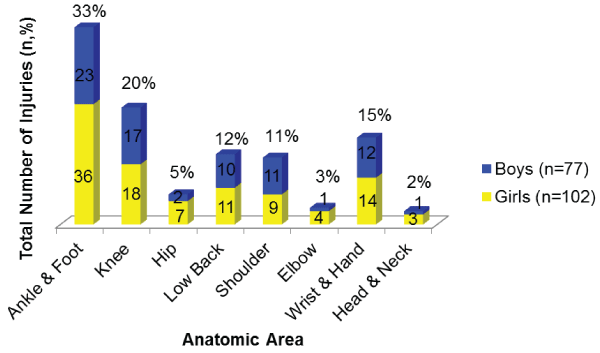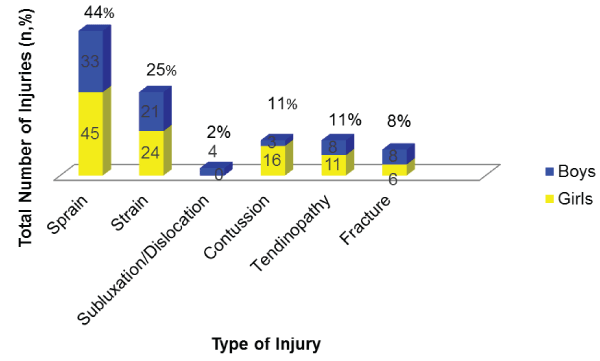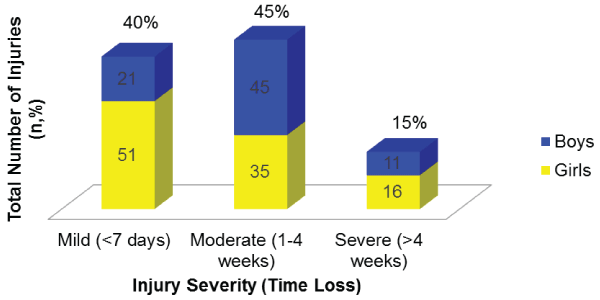International Journal of Sports and Exercise Medicine
Epidemiology of Volleyball Related Injuries in the Young Athlete
Gerardo E Miranda*, Manuel Mas, Deric Lopez, Carlos Perez and William Micheo
Department of Physical Medicine, Rehabilitation and Sports Medicine, University of Puerto Rico School of Medicine, Puerto Rico
*Corresponding author: Gerardo E Miranda, Department of Physical Medicine, Rehabilitation and Sports Medicine, University of Puerto Rico School of Medicine, Puerto Rico, Tel: 787-922-2900; E-mail: gerardo.miranda1@upr.edu
Int J Sports Exerc Med, IJSEM-1-005, (Volume 1, Issue 1), Epidemiologic Study; ISSN: 2469-5718
Received: March 31, 2015 | Accepted: April 21, 2015 | Published: April 24, 2015
Citation: Miranda GE, Mas M, Lopez D, Perez C, Micheo W (2015) Epidemiology of Volleyball Related Injuries in the Young Athlete. Int J Sports Exerc Med 1:005. 10.23937/2469-5718/1510005
Copyright: © 2015 Miranda GE, et al. This is an open-access article distributed under the terms of the Creative Commons Attribution License, which permits unrestricted use, distribution, and reproduction in any medium, provided the original author and source are credited.
Introduction
Volleyball is a worldwide sport played by approximately 200 million people [1]. It is played at different levels of competition, and organizations, starting from youth to the professional level. Young athletes get involved early in club leagues and interscholastic competition. Volleyball is currently among the most popular club sports in the United States and Puerto Rico. In Puerto Rico, approximately 300 teams participated in the Youth Volleyball Federation Club tournaments throughout the island in 2010 [2]. Year round participation leads to repetitive mechanical stress and loads to joints, muscle-tendon units, and growth plates, which makes this population susceptible to acute and overuse injuries [3].
Studies describing volleyball related injuries in this population are limited. Most evidence in the literature involves either college, professional or elite level athletes. The National Collegiate Athletic Association (NCAA) established an injury surveillance system (ISS) in which data was collected prospectively from 1988-2004 in multiple sports at the collegiate level, including women’s volleyball [4]. Several epidemiologic studies in youth volleyball have been presented recently. The British Journal of Sports Medicine published several abstracts from the International Volleyball Federation (FIVB) Medicine Congress in Slovenia on January 2011 discussing several medical issues regarding the sport [5-8]. Those studies described the epidemiology of volleyball related injuries retrospectively in adolescent high school girls, several European junior national teams, and prospectively in adult female national and professional teams. Nevertheless, most studies on the subject of volleyball injuries involve either adult male or female athletes [1,9-11]. Thus, information on volleyball related injuries in the young adolescent player is lacking.
The primary aim of this study is to describe volleyball related injuries in young athletes in Puerto Rico. Secondary aims include identification of injury patterns and possible risk factors unique to this population.
Methods
Design
Retrospective analysis of volleyball related musculoskeletal injuries.
Population
Young volleyball players, girls and boys from local volleyball club leagues participated in the study. Inclusion criteria included active participation in the volleyball club at the moment of interaction with study personnel and the presence of the parent or legal guardian.
Measurements
The Institutional Review Board (IRB) from the University of Puerto Rico approved the study. After obtaining written consents from the participant’s parent or legal guardian, and written assent by each participant, data was collected through a written questionnaire. The study personnel who were available throughout the completion process gave the questionnaire to each participant. It included demographic information such as age, height, weight, past medical history, dexterity, dominant shoulder in sport, and sport participation information including, years of volleyball experience, practice and game participation hours per week, position played, participation in other sports, and history of volleyball related injuries. For those who had suffered a volleyball related injury at any time during their active volleyball participation; the localization, mechanism, type, game versus practice situation, time elapsed since symptoms started, intervention, and time loss from sport related activity was included.
Outcome measures
Injury was defined as any event that resulted from participation in competition or practice, with consequential restriction and/or modification from participation of competition or practice for one or more days beyond the day of the incident. The primary outcome measure was the frequency of volleyball related injury in boys and girls, evaluated by anatomic area, type, mechanism, and etiology. Secondary outcome measures included association of injury to gender, age, height, weight, body mass index (BMI), position played, and time of exposure, game versus practice situation, and injury severity, which was defined as time loss from full sport participation. Injuries were classified as mild (1-7 days), moderate (1-4 weeks), or severe (>4 weeks) [12].
Analysis
Microsoft Excel software was used for all the data analysis. Standard descriptive frequency analysis was used to describe the data collected. Statistical methods for comparison and test of association included student t-tests, and chi-square tests, respectively. A p value of ≤ 0.05 was taken as an indication of statistical significance.
Results
A total of two hundred and ten participants completed the questionnaire [boys (n=105) and girls (n=105)]. Subject gender, age, height, weight, and BMI were described according to presence of injury (Table 1). Sixty one percent (n=64) of girls and fifty percent (n=53) of boys reported a history of at least one volleyball related injury (Table 1). No statistically significant difference was found when comparing injury total between genders (p=0.13). A total of one hundred and seventy-nine (179) injuries were reported, one hundred and two (102) by the girls and seventy-seven (77) by the boys. In this population the overall injury rate was 0.85 per participant (0.97 in girls, 0.73 in boys). A significant difference in injured and non-injured boys was only observed in weight (p=0.00) and BMI (p=0.03), but not in age or height. Moreover, there was no association between girls (injured or non-injured) and age, height, weight, or BMI.
![]()
Table 1: Subjects
View Table 1
Injury by type and anatomic area
Acute injuries, such as sprains, strains, and contusions were more commonly reported. The lower extremities accounted for most injuries (58%); the ankle was the most commonly injured body part. In the upper extremities acute injuries more often affected the wrist and hand (Graph 1). Meanwhile, overuse injuries were evenly distributed in the shoulder, back/trunk, and knee. Furthermore, sprain was the most frequent type of injury, especially acute ankle injuries, while shoulder tendinopathy was the most frequent overuse injury (Graph 2).
Mechanism of injury
The most common mechanism of acute injuries was contact with floor (33%) and contact with another player (23%), whereas overuse injuries occurred without contact (27%).
Injury by position, time exposure, and setting
The front row positions (outside hitter, middle blocker, opposite hitter) were injured more often than the back row (libero, setter) or players that played both positions, although the results did not reach a statistically significant difference when compared to their non-injured counterparts (p=0.18). In terms of time of exposure there was no significant difference between those who had more than six hours of weekly exposure from those who had less than six hours (p=0.61). Game time injuries were more common in the boys (57%), while injuries during practice were more frequent in the girls (56%). This difference did not reach statistical significance (p=0.08).
Severity of injury
Most injuries were moderate in severity without a significant gender difference (p=1.63). Mild injuries were more common in girls, while moderate injuries were more frequently found in boys (Graph 3).
Discussion
Our descriptive study of volleyball related injuries in young athletes demonstrates an overall injury frequency of 55.7% in this population. Young girls are more commonly injured (61%) than boys (50%) with an overall injury rate of 0.85 per participant. Greater weight and BMI appear to increase the risk of injury occurrence in boys. Most injuries were acute sprains secondary to contact with the floor or another player affecting the lower extremities, especially the ankle. Overall injuries were moderate in severity.
In this study more than half of the participants had sustained a volleyball related injury. The injury rate was 0.85 per participant with a higher rate among girls (0.97) than boys (0.73); although this difference was not statistically significant. Traditionally, volleyball has been a safer sport when compared to football, wrestling, gymnastics, and basketball in the high school population [13]. In a retrospective study, Vanderlei et al. [3] reported an injury rate of 0.23 per participant and 1.19 per injured participant in young volleyball players in Brazil. Another retrospective study by Yasher et al. [5] described a low prevalence of volleyball related injuries in a population of high school girls. The injury rate in our study was higher than reported for this population. Early exposure to the sport, since most participants had more than two years of volleyball experience, and year-round participation may have influenced these findings. However, comparison with other studies is difficult due to inconsistency in study design, population, outcome measures, and terminology.
We found that heavier boys with a higher BMI were injured more frequently. Although not statistically significant, older and taller boys appear to be injured more frequently as well. On the other hand, only heavier girls with a higher BMI appear to be more prone to injury. Vanderlei et al. [3] found a similar association regarding age, height, weight and BMI in both boys and girls. Older, taller boys are probably more active around the net where most acute injuries occur, and may be exposed to higher number of repetitions increasing the mechanical load on their growing bodies. Moreover, the heavier boys may be less physically fit which could translate into muscle imbalances and neuromuscular deficits.
Acute ankle sprain was the most common encountered injury. Most injuries were secondary to an acute traumatic event involving the lower extremities. This type of injury is common in all levels of competition and the injury mechanism was similar to that described in other studies where contact with another player or contact with the floor were the main cause of injury [3,4]. On the other hand, overuse injuries were uncommon in this population; typically involving the shoulders, low back/trunk, and knees. These findings are consistent with previously published volleyball literature [1,4-8].
Overall injury occurrence was similar during game or practice. However, although not statistically significant (p=0.08) there is a tendency towards a higher number of injuries during practice in girls and during games in boys. Studies involving a higher level of competition, such as, elite junior volleyball, college, professional leagues demonstrate a higher incidence of injury during games [1,4,7,9]. Our girl population spends more time in practice than in game, thus making them more prone to injury during that time due an increase exposure. The tendency towards an increase number of injuries in the boys during the game could be secondary to a higher level of competition which requires more risk taking during matches, especially at the net [1].
In terms of position played in the court, front row players suffered more injuries [1,4]. There is not a significant association of player position and increase number of injuries, although most acute injuries occur during net play and a large number of our subjects had been playing a specific position from early in their careers. Early court position specialization may lead to an increase risk of acute injury as well as long term increase risk of overuse injury [14,15].
Our study showed that most injuries were moderate in severity without significant gender differences. Mild injuries were more frequent in girls and moderate injuries in boys. This finding is consistent with other studies [4,7]S. Injury intervention was not optimal in our population in that only less than half of injured players were evaluated by a physician. Consequently, adequate medical assessment, intervention, or treatment was probably not undertaken. Misdiagnosis of injuries may have led to earlier return to play than expected and misclassification of injury severity. Therefore, parents, coaches, and players need to be more conscious of possible health issues during practice and competition to ensure the safety of the young athlete.
This study presents several limitations. First of all, the sample of the population is small limiting the power of the study. Secondly, information was gathered retrospectively using questionnaires filled by each player presenting a recall bias on the information provided. Additionally, players that did not seek medical attention may have provided the wrong diagnosis during the interview. To limit this error, the questionnaire was given by educated study personnel familiar with volleyball related injury diagnosis. Thirdly, injury association with the different anthropometric measurements do not necessarily correlate with injuries that occurs in the past limiting the injury risk estimation. Lastly, we were unable to establish injury incidence or risk because athlete exposure was not documented.
Conclusion
Volleyball related injuries occur in all levels of play. Young female players present with a higher number of volleyball injuries when compared to young boys. Weight and BMI are factors associated with an increase number of injured boys, but other factors that may play a role in injury risk are age, female gender, height, front row position, contact with another player or floor, and game exposure on boys. Further research needs to be done in this population, other age groups, and competition levels, in order to better understand if these elements alter injury patterns, mechanism, and risk factors.
References
-
Verhagen EA, Van der Beek AJ, Bouter LM, Bahr RM, Van Mechelen W (2004) A one season prospective cohort study of volleyball injuries. Br J Sports Med 38: 477-481.
-
(2010) Puertorican federation of volleyball.
-
Vanderlei FM, Bastos FN, Tsutsumi GY, Vanderlei LC, Netto Júnior J, et al. (2013) Characteristics and contributing factors related to sports injuries in young volleyball players. BMC Res Notes 6: 415.
-
Agel J, Palmieri-Smith RM, Dick R, Wojtys EM, Marshall SW (2007) Descriptive epidemiology of collegiate women's volleyball injuries: National Collegiate Athletic Association Injury Surveillance System, 1988-1989 through 2003-2004. J Athl Train 42: 295-302.
-
Yasher KR, Liller K, Wong S, Jang S, Morris BJ, et al. (2011) An analysis of volleyball injuries in female athletes in grades nine through twelve. Br J Sports Med 45: 546.
-
Sattler T (2011) Intrinsic risk factors for sport injuries in female volleyball. Br J Sports Med 45: 533-534.
-
Nesic G, Ilic V, Sikimic M, Dopsaj M (2011) Incidence of volleyball injuries in elite junior female players: A retrospective cohort study. Br J Sports Med 45: 546.
-
Massada M, Aido R, Magalhaes C, Puga N (2011) Injury epidemiology: Volleyball injuries: A survey of injuries of the portuguese female national team. Br J Sports Med 45: 533-534.
-
Bahr R, Bahr IA (1997) Incidence of acute volleyball injuries: a prospective cohort study of injury mechanisms and risk factors. Scand J Med Sci Sports 7: 166-171.
-
Schafle MD (1993) Common injuries in volleyball. Treatment, prevention and rehabilitation. Sports Med 16: 126-129.
-
Wang HK, Cochrane T (2001) A descriptive epidemiological study of shoulder injury in top level english male volleyball players. Int J sports Med 22: 159-163.
-
Le Gall F, Carling C, Reilly T, Vandewalle H, Church J, et al. (2006) Incidence of injuries in elite French youth soccer players: a 10-season study. Am J Sports Med 34: 928-938.
-
Adirim TA, Cheng TL (2003) Overview of injuries in the young athlete. Sports Med 33: 75-81.
-
Jayanthi N, Pinkham C, Dugas L, Patrick B, Labella C (2013) Sports specialization in young athletes: evidence-based recommendations. Sports Health 5: 251-257.
-
DiFiori JP, Benjamin HJ, Brenner J, Gregory A, Jayanthi N, et al. (2014) Overuse injuries and burnout in youth sports: A position statement from the american medical society for sports medicine. Clin J Sport Med 24: 3-20.








